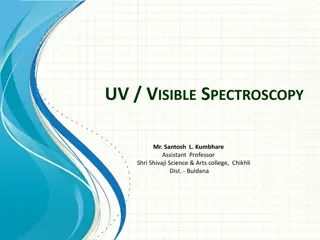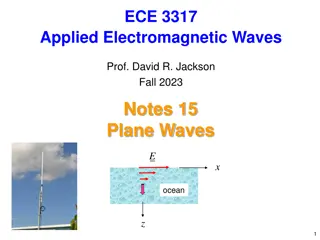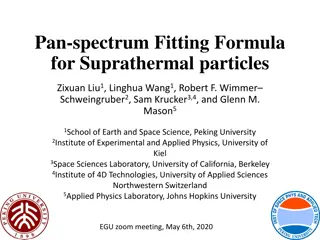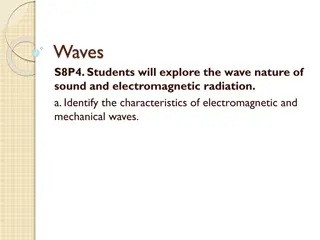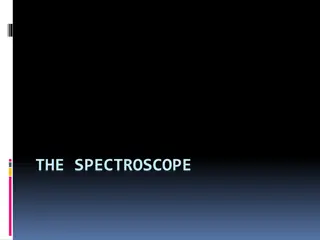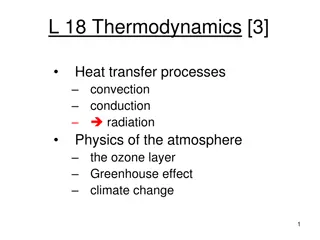The Electromagnetic Spectrum
Encompassing various types of EM radiation, the electromagnetic spectrum spans from visible light to gamma-rays. Explore the roles of different radiation types, from radio waves to X-rays, in our daily lives and beyond. Delve into the laws of transmission, including reflection, refraction, absorption, and attenuation, shedding light on how electromagnetic radiation interacts with matter.
Uploaded on Feb 28, 2025 | 0 Views
Download Presentation

Please find below an Image/Link to download the presentation.
The content on the website is provided AS IS for your information and personal use only. It may not be sold, licensed, or shared on other websites without obtaining consent from the author.If you encounter any issues during the download, it is possible that the publisher has removed the file from their server.
You are allowed to download the files provided on this website for personal or commercial use, subject to the condition that they are used lawfully. All files are the property of their respective owners.
The content on the website is provided AS IS for your information and personal use only. It may not be sold, licensed, or shared on other websites without obtaining consent from the author.
E N D
Presentation Transcript
Dr Kapil Garg Dept. Of Musculoskeletal Physiotherapy MGM Institute Of Physiotherapy Chh. Sambhajinagar
The electromagnetic spectrum is the range of all types of EM radiation. Radiation is energy that travels and spreads out as it goes the visible light that comes from a lamp in your house and the radio waves that come from a radio station are two types of electromagnetic radiation. The other types of EM radiation that make up the electromagnetic spectrum are microwaves, infrared light, ultraviolet light, X- rays and gamma-rays.
Radio: Your radio captures radio waves emitted by radio stations, bringing your favorite tunes. Radio waves are also emitted by stars and gases in space. Microwave: Microwave radiation will cook your popcorn in just a few minutes, but is also used by astronomers to learn about the structure of nearby galaxies. Infrared: Night vision goggles pick up the infrared light emitted by our skin and objects with heat. In space, infrared light helps us map the dust between stars.
Visible: Our eyes detect visible light. Fireflies, light bulbs, and stars all emit visible light. Ultraviolet: Ultraviolet radiation is emitted by the Sun and are the reason skin tans and burns. "Hot" objects in space emit UV radiation as well. X-ray: A dentist uses X-rays to image your teeth, and airport security uses them to see through your bag. Hot gases in the Universealso emit X-rays. Gamma ray: Doctors use gamma-ray imaging to see inside your body. The biggest gamma-ray generator of all is the Universe
Laws of transmission Reflection Refraction Absorption Attenuation
Reflection is the process by which electromagnetic radiation is returned either at the boundary between two media (surface reflection) or at the interior of a medium (volume reflection). Transmission is the passage of electromagnetic radiation through a medium. Both processes can be accompanied by diffusion which is the process of deflecting a unidirectional beam into many directions. In this case, we speak about reflection and diffuse transmission diffuse
Absorption is the transformation of radiant power to another type of energy, usually heat, by interaction with matter. Attenuation is a general term that refers to any reduction in the strength of a Attenuation occurs with any type of energy, whether digital or analog. Sometimes called loss, attenuation is a natural consequence of signal transmission over long distances. signal/energy.
Electro magnetic radiation Electromagnetic radiation can be expressed in terms of energy, wavelength, or frequency. Frequency is measured in cycles per second, or Hertz. Wavelength is measured in meters. Energy is measured in electron volts. Each of these three quantities for describing EM radiation are related to each other in a precise mathematical way
Laws of Radiation Kirchoff s Law Any grey object (other than a perfect black body) which receives radiation, disposes off a part of it in reflection and transmission. reflectivity and transmissivity are each less than or equal to unity. Kirchoffs law states that the absorptivity of a substance for radiation of a specific wavelength is equal to its emissivity for the same wavelength and is given by the following equation: The absorptivity,
All bodies absorb energy as well as transmit it. Good absorber at a given wavelength is also a good radiator at the same wavelength. If the body radiates maximum intensity of all wavelengths it is called a black body or perfect radiator. Fresh snow absorbs the infra-red radiation from the earth and atmosphere, while it reflects the radiation from the sun. Radiation intensity increases with temperature. The higher the temperature, the shorter the wavelength.
Stefan-Boltzmans Law This law states that the intensity of radiation emitted by a radiating body is proportional to the fourth power of the absolute temperature of that body Planck s Law Electromagnetic radiation consists of flow of quanta or particles and the energy content (E) of each quantum is proportional to the frequency
Weins Displacement Law According to this law, the wavelength of maximum intensity of emission of radiation from a black body is inversely proportional to the absolute temperature of the radiating body
The law of reflection The law of reflection defines that upon reflection from a smooth surface, the angle of the reflected ray is equal to the angle of the incident ray, with respect to the normal to the surface that is to a line perpendicular to the surface at the point of contact. The reflected ray is always in the plane defined by the incident ray and the normal to the surface at the point of contact of the incident ray. The images produced by plane mirrors and curved mirrors can be understood by the law of reflection. The principle when the light rays falls on the smooth surface, the angle of reflection is equal to the angle of incidence, also the incident ray, the reflected ray, and the normal to the surface all lie in the same plane
Laws of refraction state that: The incident ray, reflected ray and the normal, to the interface of any two given mediums, all lie in the same plane. The ratio of the sine of the angle of incidence and sine of the angle of refraction is constant. This is also known as Snell's law of refraction. Lambert's law of absorption states that equal parts in the same absorbing medium absorb equal fractions of the light that enters them.
The electromagnetic radiation describes that measured light intensity is inversely proportional to the distance squared from the source of radiation. inverse square law for Photons are distributed with respect to area, a squared unit. The reasoning for the inverse square law is geometric in nature
The GrotthussDraper law (also called the Principle of Photochemical Activation) states that only that light which is absorbed by a system can bring about a photochemical change. When light falls on any substance, only a fraction of it is absorbed whereas the rest is either reflected or transmitted. It is only the absorbed light which is effective in bringing about a chemical reaction
Lamberts Cosine Law holds that the radiation per unit solid angle (the radiant intensity) from a flat surface varies with the cosine of the angle to the surface normal such as arcs, are basically spherical. These appear like a uniform flat disk as a result of the cosine law
Attenuation electromagnetic radiation due to absorption or scattering of photons. ... Therefore, calculation of the total change in intensity involves both the inverse- square law and an estimation of attenuation over the path. decreases the intensity of









